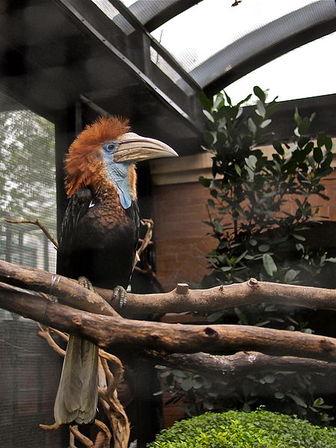Yellow-casqued Hornbill
Yellow-casqued Hornbills are one of the largest birds of the forest, with adults weighing up to 2 kg. They live mainly in the forest canopy, feeding on the ground only rarely. They live in small family groups containing at least one adult male and female, with one or two immature birds, though they sometimes gather in larger flocks to exploit a major food supply such as an ant or termite nest.

Original source: Denise ChanPermission(Reusing this file)This image, which was originally posted to Flickr.com, was uploaded to Commons using Flickr upload bot on 09:51, 20 March 2010 (UTC) by Snowmanradio (talk). On that date it was licensed under the license below. This file is licensed under the Creative Commons Attribution-Share Alike 2.0 Generic license.You are free:to share – to copy, distribute and transmit the work
Author: Denise ChanPermission(Reusing this file)This image, which was originally posted to Flickr.com, was uploaded to Commons using Flickr upload bot on 09:51, 20 March 2010 (UTC) by Snowmanradio (talk). On that date it was licensed under the license below. This file is licensed under the Creative Commons Attribution-Share Alike 2.0 Generic license.You are free:to share – to copy, distribute and transmit the work
The Yellow-casqued Hornbill is classified as Near Threatened (NT), is close to qualifying for or is likely to qualify for a threatened category in the near future.
The Yellow-casqued Hornbill (Ceratogymna elata) is found in the primeval rain forest of coastal regions of West Africa, for example in Côte d'Ivoire. Yellow-casqued Hornbills are one of the largest birds of the forest, with adults weighing up to 2 kg. They live mainly in the forest canopy, feeding on the ground only rarely. More
Images Yellow-casqued hornbill in tree Yellow-casqued hornbill in tree Species related by - * Family group * Habitat * Conservation status * * View image slideshow * Link to this image * Email to a friend * * MyARKive menu More
Yellow-casqued hornbill in tree Yellow-casqued hornbill in treePrint factsheet Facts - Also known as: Yellow-casqued wattled hornbill French: Calao À Casque Jaune Kingdom Animalia Phylum Chordata Class Aves Order Coraciiformes Family Bucerotidae More
Wildlife: Yellow-casqued Hornbill is a post from: Listen to Africa Posted January 15, 2010 Original Post » Comments » Last 5 Posts = Soundscape: Chain ferry to Guinea - Download media Juice It! We reached the river that demarcates the Guinea-Bissau / Guinea border between Pitche and Foula Mouri early, while wisps of mist still hung over the river. More
Yellow-casqued Hornbills are one of the largest birds of the forest, with adults weighing up to 2 kg. They live mainly in the forest canopy, feeding on the ground only rarely. They live in small family groups containing at least one adult male and female, with one or two immature birds, though they sometimes gather in larger flocks to exploit a major food supply such as an ant or termite nest. More
Family : Bucerotidae
Genus : Ceratogymna
Species : elata
Authority : (Temminck, 1831)
